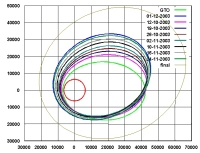No. 9 - SMART-1 is changing thrust strategy to avoid long eclipses
As reported earlier, the cause of the problem has been identified and a procedure to automatically detect these events and restart the engine autonomously was prepared. The procedure will be uploaded to the on-board software this week. Despite the fact that the solar activity at the moment is considerably reduced, compared with the high activity of recent weeks, we suspect that the density of trapped protons at low altitudes of the radiation belts is still quite high and is causing the flame-outs. We have therefore decided not to thrust when the spacecraft's altitude is below 10 000 km.
The total cumulated thrust time is now more than 810 hours and we have consumed almost 13 kg of Xenon. Even with this small amount of fuel consumption the electric propulsion engine has so far provided a velocity increment of about 567 ms-1 (equivalent to more than 2000 kmh-1). The electric propulsion engine's performance, periodically monitored by means of the telemetry data transmitted by the spacecraft and by radio-tracking at the ground stations, continues to show a small over performance in thrust, varying from 1.3% to 1.8% over this period.
On the 28 November we changed the thrust direction strategy. Up until this date the spacecraft has been thrusting in the direction of the velocity vector, tangentially to the orbit. This direction maximises the increase of the semi-major axis, causing both the perigee and the apogee altitudes to increase. This optimal strategy leads to quite a high apogee at the end of the radiation escape phase, which is good because it brings SMART-1 closer to the Moon. The downside of this strategy is that it causes the spacecraft to transit around apogee for longer periods of time.
If the spacecraft had continued along this vector then by mid-March 2004 the apogee would be in the ecliptic plane and the spacecraft would frequently transit for more than 2 hours through the shadow produced by the Earth. In order to avoid such a situation, which the spacecraft has not been designed for, we have decided to change the thrust strategy. The spacecraft now thrusts in a direction perpendicular to the position vector in the orbital plane.
This new strategy produces a faster perigee increase, and will lead to an earlier escape from the radiation belts and a lower apogee height. With a lower apogee height, the spacecraft will transit at higher speeds through the Earth's shadow cone and it will be eclipsed for a maximum of 2 hours.
Once substantially outside the radiation belts (at a perigee height of 20 000 km), thrusting will be performed only at perigee for short periods to tune the apogee height to match the maximum allowable eclipse duration, which is currently under evaluation. This new strategy entails the introduction, in about a month's time, of coast arcs (parts of the orbit when there is no thrust) of considerable duration. These will be used to perform instrument commissioning and preliminary scientific observations.
The degradation of the electrical power produced by the solar arrays has been much less over the last week than previously. As a matter of fact the power available has remained more or less constant over the last 9 days. This means that the degradation by radiation has matched the increase of solar irradiance of about 0.4 %, so that the net effect on the power produced is nil. This is explained by the fact that no direct proton radiation from solar activity was experienced and the fact that the spacecraft stays outside the radiation belts for a considerable part of the time in its current orbit.
The communication, data handling and on-board software subsystems have been performing very well in this period. In particular the counted number of the single event upsets corrected by the processor EDAC system is drastically decreasing. We are now at a rate of two or three events per day.
The thermal subsystem also continues to perform well and all the temperatures are as expected. The reported problem of the high temperature of the star trackers optical heads has been investigated further through detailed in-orbit observations. We are now starting a ground simulation campaign to correlate the in-orbit data with the thermal mathematical models. The situation is under control and more on this will be reported as soon as it becomes available.
Orbital/Trajectory information
The SMART-1 orbit is continuously modified by the effects of the electric propulsion low thrust. The osculating orbital elements are periodically computed by the ESOC specialists. These elements define the so called osculating orbit which would be travelled by the spacecraft if at that instant all perturbations, including EP thrust, would cease. So it is an image of the situation at that epoch. In reality the path travelled by the spacecraft is a continuous spiral leading from one orbit to another. The most recent osculating elements are as follows:
|
EPOCH (UTC) 2003/12/01 10:29:20.1 Elements WRT Earth (J2000) |
|
| Pericentre Distance (km) |
12161.319930 |
| Apocentre Distance (km) |
48309.072083 |
| Semi Major Axis (km) |
30235.196007 |
| Eccentricity |
0.597776 |
| Inclination (deg) |
6.848195 |
| Asc. Node (deg) |
153.996240 |
| Arg. of Pericentre (deg) |
205.839383 |
| True Anomaly (deg) |
180.000212 |
| Osc. Orbital Period (h) |
14.533749 |
 |
|
SMART-1 orbit up to 1-12-2003 |
From the start, the electric propulsion system has managed to increase the semi-major axis of the orbit by 5606 km, increasing the perigee altitude from the original 656 km to 5783 km and the orbital period by three hours and 50 minutes, from the initial 10 hours 41 minutes to the present 14 hours 31 minutes.
Contact Point
Giuseppe Racca
SMART-1 Project Manager
ESA/ESTEC - SCI-PD
Keplerlaan 1- 2200 AG Noordwijk, The Netherlands
E-mail: Giuseppe.Racca esa.int
esa.int

